Written by: 100y
Translated by: Yangz, Techub News
A few years ago, I predicted the possibility of Uniswap developing its own network, but at that time, I thought the likelihood was low due to potential user experience issues. However, just last night, Uniswap officially announced the launch of its own L2 solution, Unichain, which immediately overturned my prediction.
Although the white paper for Unichain is only three pages long, a closer look reveals it to be a masterpiece. It brings together Uniswap's long-standing focus on user experience, the latest MEV research from Flashbots, and the vast ecosystem built on OP-Stack. While the content is brief, the white paper touches on complex topics such as TEE, priority ordering, and MEV tax, which may be challenging for readers unfamiliar with the basics of MEV. Therefore, this article aims to provide a quick and simple breakdown of Unichain's main features for easier understanding.
Problems with Uniswap
Uniswap is the leading AMM DEX in the Ethereum ecosystem, currently deployed on 25 networks with a total TVL of approximately $4.5 billion. Although Uniswap is regarded as one of the most successful protocols, it still faces limitations from the networks it operates on.
For example, while Ethereum offers significant liquidity, it suffers from low scalability and is vulnerable to malicious MEV (Maximum Extractable Value) impacts. Various Rollup solutions have emerged to address these issues, but most Rollups are currently operated by a single sequencer, which can lead to potential single points of failure, such as validity failures and censorship.
Additionally, the block construction process on Ethereum and Rollups involves a public mempool, creating an environment for users (searchers) to extract MEV (both good and bad) from other users. Furthermore, due to the structure of the MEV value chain, there is an imbalance where proposers can capture varying proportions of value while users do not benefit.
Enter Unichain
Overview
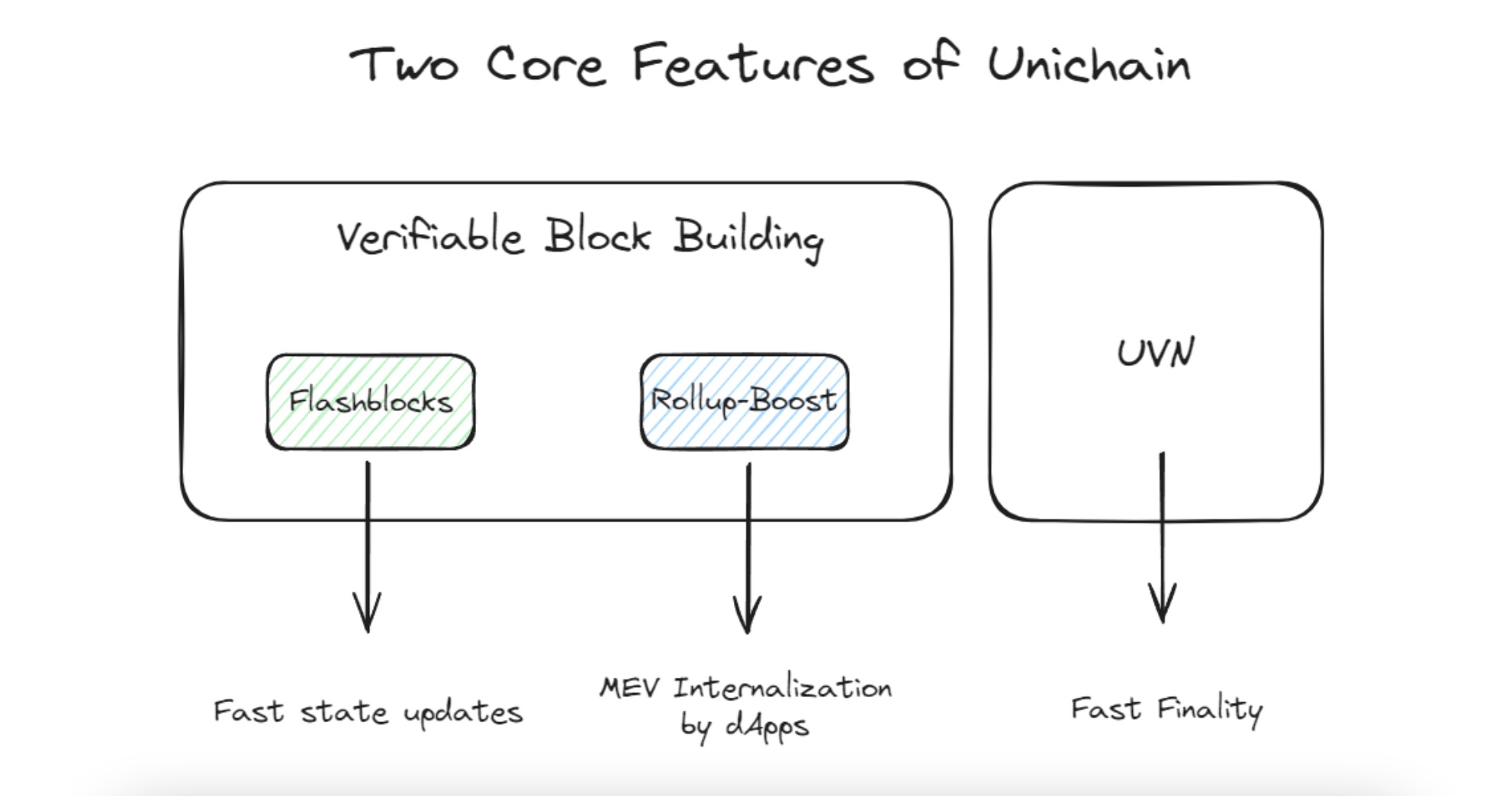
Unichain is an Ethereum Optimistic Rollup based on OP Stack, launched by Uniswap, Flashbots, OP Labs, and Paradigm, aimed at addressing the aforementioned issues. Unichain offers several key advantages through verifiable block construction and the Unichain Verification Network (UVN):
Fast state updates
Enabling applications to extract and internalize MEV
Quick settlement through rapid economic finality
In addition to being an upgraded version based on OP Stack, Unichain also plans to participate in the Optimism Superchain ecosystem. Besides its native fast settlement feature, this integration is expected to provide users with a seamless liquidity experience through cross-chain solutions within the Superchain ecosystem.
Now, let’s take a closer look at how Unichain brings these advantages.
Verifiable Block Construction
Verifiable block construction is achieved through Rollup-Boost, a feature developed in collaboration with Flashbots. Rollup-Boost provides two key functionalities, including Flashblocks and verifiable priority ordering. Similar to MEV-Boost, Rollup-Boost can also be used as auxiliary software.
Flashblocks
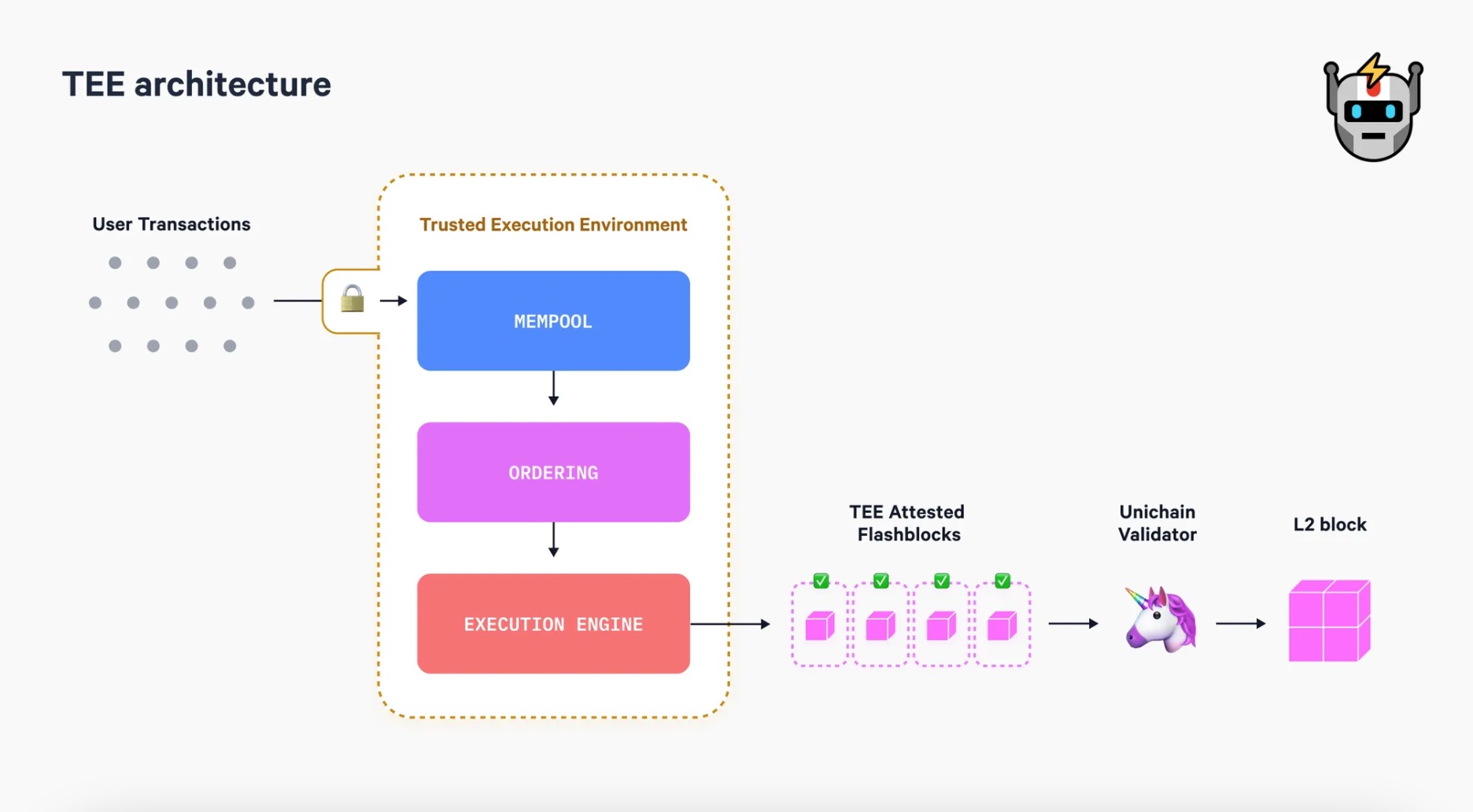
Flashblocks are pre-confirmations issued by builders in a trusted execution environment (TEE), which we will explore in detail below. Unichain generates partial blocks, dividing a single block into four parts, with each partial block generated every 250 milliseconds and sent to the sequencer.
The sequencer continuously downloads these partial blocks while executing transactions, providing users with early execution confirmations. The sequencer guarantees that these partial blocks will be included in the final proposed block. This process accelerates state updates, reduces latency, improves user experience, and mitigates malicious MEV.
Verifiable Priority Ordering
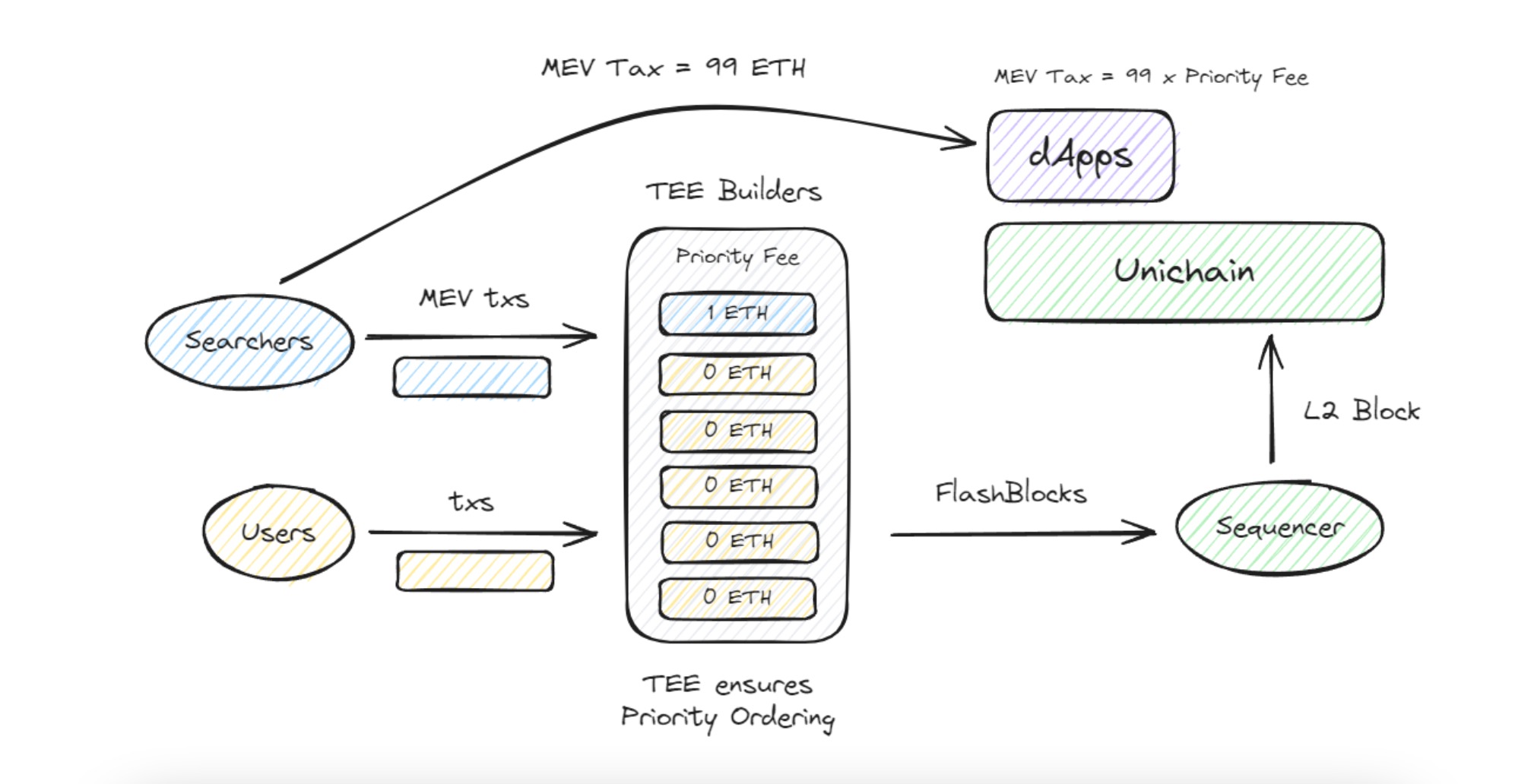
Priority Ordering
Priority Ordering is a block construction mechanism proposed by Paradigm's Dan Robinson and Dave White. It assumes that block proposers sort transactions solely based on priority fees, without engaging in censorship or delaying actions. This model is only feasible when there is a single or trusted block proposer. In a competitive environment like Ethereum L1, where multiple proposers build blocks, priority ordering is not viable.
The goal of priority ordering is to allow DApps on the mainnet to levy MEV taxes on transactions interacting with them, thereby extracting a portion of the MEV value. This value can be used internally by the DApp or redistributed to users. The MEV tax is a fee levied by smart contracts on transactions, which can be set as a function of transaction priority fees. Here’s a simple example.
A DEX on Unichain, 100y, wants to directly extract MEV from MEV transactions on its exchange. Since it knows that blocks on Unichain are constructed using priority ordering, this means that the MEV value of any transaction is entirely determined by its priority fee. Suppose 100y sets the MEV tax equal to 99 times the transaction priority fee. Then, if an arbitrage opportunity worth 100 ETH arises, how much maximum priority fee does the MEV searcher need to submit to extract that MEV? The answer is 1 ETH. Setting the priority fee to 1 ETH results in a 99 ETH MEV tax, totaling 100 ETH. If the searcher sets a priority fee higher than 1 ETH, the total cost will exceed 100 ETH, leading to a loss. Therefore, 100y can capture at most 99 ETH of the 100 ETH MEV value.
As for ordinary users who do not capture MEV value, the priority fees will be set lower, meaning that 100y will not extract value from these transactions. Instead, it will only capture the MEV value represented by the priority fees. This setup allows applications on Unichain to directly extract MEV, opening up various potential use cases.
Utilizing TEE for Verifiability
The key here is to ensure that the entities responsible for block construction use the priority ordering mechanism. To this end, Unichain has taken two measures. First, it separates the sequencer and block builders, similar to the PBS model. Second, it mandates that block builders use TEE (Trusted Execution Environment), allowing anyone to verify whether the priority ordering mechanism is being utilized.
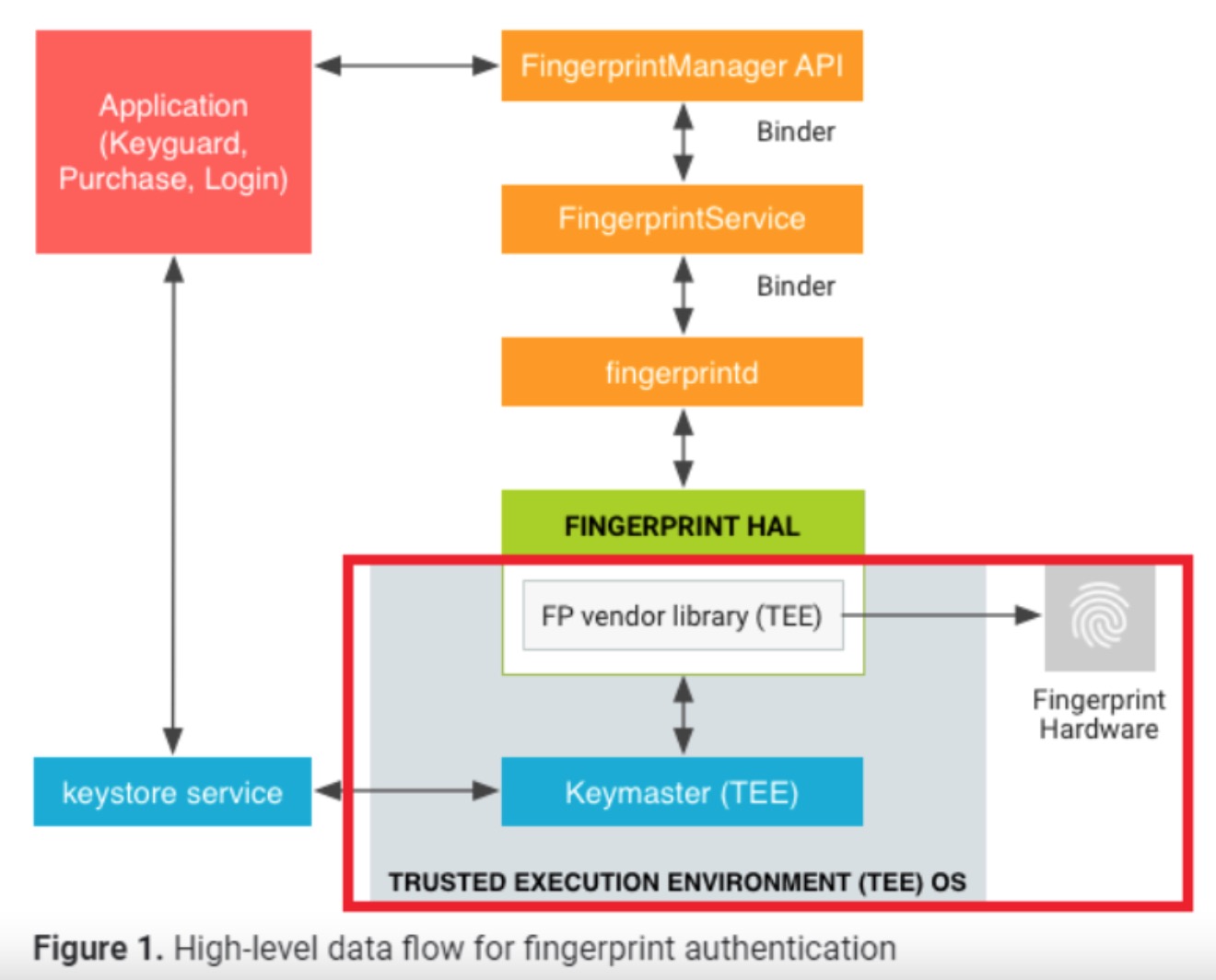
TEE is a secure area within hardware such as CPUs that operates independently of other parts of the system, allowing for the secure handling of sensitive data. TEE ensures the secure execution of trusted code, even if the external environment is compromised. Notable examples include ARM's TrustZone and Intel's SGX. A common example is how biometric data, such as fingerprints or facial recognition, is processed within a TEE on mobile devices.
This design can even prevent operating systems or programs with administrative privileges from accessing the secure area. To ensure that the code running in the TEE is trustworthy, a verification process is required. This verification ensures that the TEE remains secure and untampered. For instance, in Intel SGX, a hash value is generated to represent the code and data within SGX, while a hardware-managed private key proves the integrity of the code.
The block construction process of Unichain occurs within the trusted execution environment of TEE builders. Due to the characteristics of TEE, these builders can initially submit a proof to demonstrate to users that they are using the priority ordering block construction mechanism. This combination of functionalities ensures that applications on Unichain can reliably extract a portion of MEV revenue.
Unichain Verification Network (UVN)
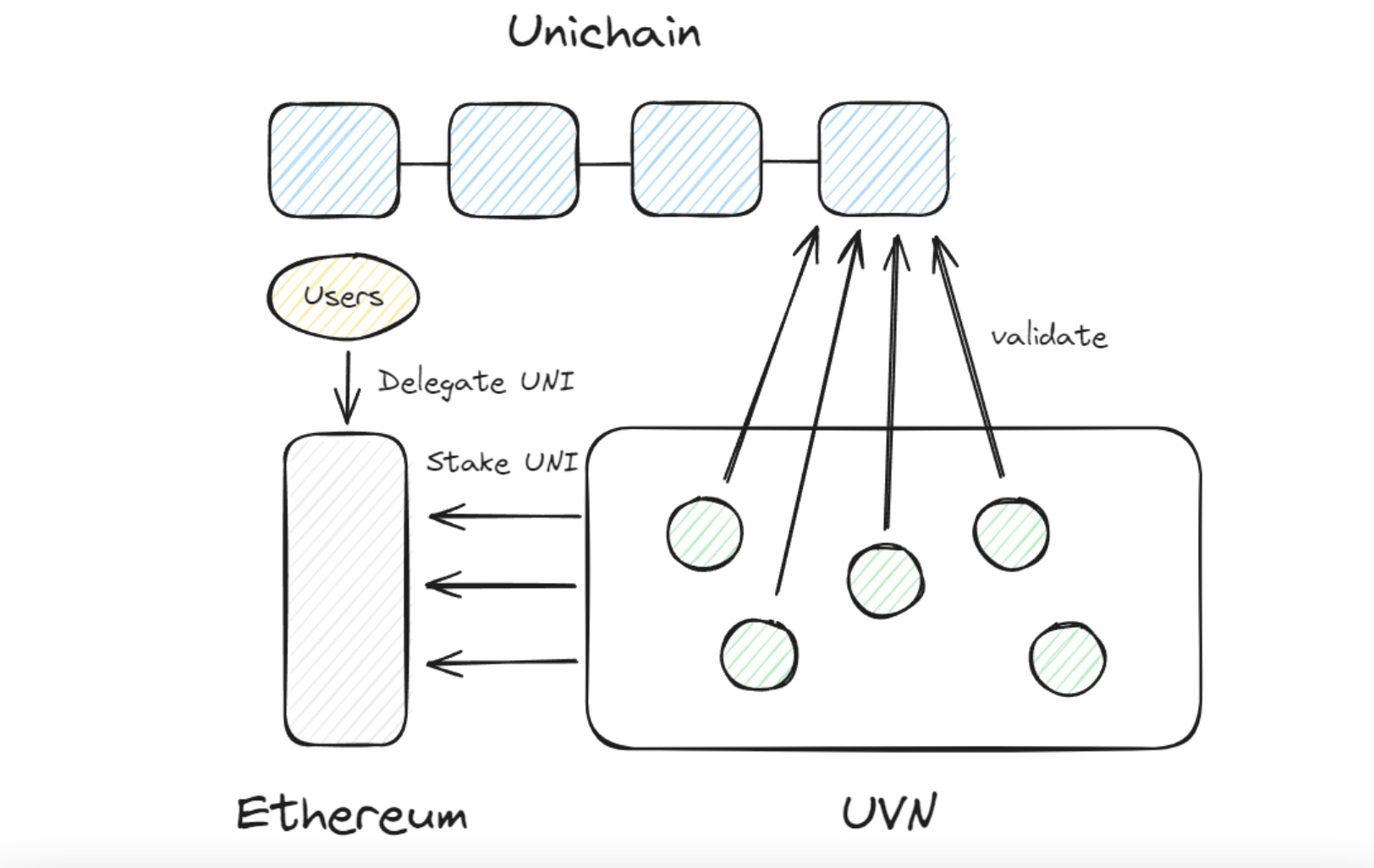
The Unichain Verification Network is a decentralized network composed of node operators responsible for verifying the latest state of Unichain and providing rapid finality, achieving seamless cross-chain transactions through economic security. This concept is similar to AltLayer's MACH (achieving rapid finality using EigenLayer), Nuffle's rapid finality layer, and the recently proposed rapid finality concept by Symbiotic.
To become a decentralized node on Unichain, participants must stake UNI on the Ethereum mainnet. Each epoch, the nodes with the highest staked UNI balance will be selected for the active node set and will participate in validation by running the Reth Unichain client. Additionally, similar to other networks, UNI holders can choose to delegate their stakes.
Summary
As a DApp, Uniswap has achieved a strong product-market fit, and I am optimistic about its transition to a specific application L2 based on Ethereum, especially considering its efforts to expand its ecosystem. However, liquidity fragmentation remains a significant challenge, and it will be crucial to see how the Uniswap team provides a seamless cross-chain trading experience between Ethereum L1 and Unichain L2.
From an investment perspective, the UNI token will now be used as the staking token for UVN. Given the strong performance of restaking protocols like EigenLayer, Symbiotic, and Karak, we can expect a substantial amount of UNI to be deposited into UVN, which will greatly enhance the value accumulation of UNI. Since the announcement of Unichain, UNI has already risen by about 12%, entering the top 20 by market capitalization. Considering UNI's market cap is already high compared to other tokens, it will be interesting to further understand the impact of UNI staking on its future price.
免责声明:本文章仅代表作者个人观点,不代表本平台的立场和观点。本文章仅供信息分享,不构成对任何人的任何投资建议。用户与作者之间的任何争议,与本平台无关。如网页中刊载的文章或图片涉及侵权,请提供相关的权利证明和身份证明发送邮件到support@aicoin.com,本平台相关工作人员将会进行核查。




